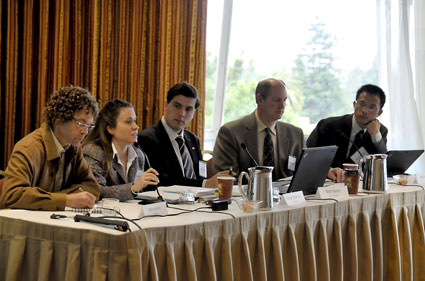Eco-driving: Ready for prime time?
The time may finally be right to sell Americans on eco-driving, according to a group of transportation experts from four University of California campuses as well as representatives from industry and government who attended an all-day conference on May 18.
Eco-driving, sometimes called green driving, refers to techniques drivers can use to maximize their mileage while saving fuel and minimizing tailpipe emissions. Simple eco-driving maneuvers include accelerating slowly, avoiding sudden braking, keeping tires properly inflated, and maintaining a steady speed.
But eco-driving is evolving. Researchers have been augmenting simple green-driving strategies, not only with in-vehicle feedback messages that let drivers know when they’re saving gas, but with more sophisticated techniques such as providing real-time information on faster, greener routes, as well as vehicle-to-vehicle communications that help smooth freeway traffic and cut stop-and-go driving.

UC researchers are optimistic that these new, improved eco-driving techniques can cut fuel use by 10 to 20 percent, a significant amount given the tough emission reduction requirements the state must meet over the next eight years under AB32, the Global Warming Solutions Act.
“Now may be the right time to push eco-driving due to a combination of factors,” said Susan Shaheen, co-director of UC Berkeley’s Transportation Sustainability Research Center (TSRC), who is working on several eco-driving projects. “Rising fuel prices, climate change, the urgency of meeting AB 32 targets, and the fact that the technology is improving all make this a good time to pursue eco-driving and its possibilities.”
Elliot Martin, a TSRC researcher, echoed that sentiment adding that eco-driving might succeed now because it is perceived as “low-hanging fruit at a time when the state’s economic plight makes infrastructure investment unlikely.”
Ken Kurani, a research engineer associated with the UC Davis' Institute of Transportation Studies, added that there is “increasing pressure to adopt green lifestyles,” which he believes translates into drivers thinking better of themselves if they adopt eco-driving techniques.
New, Improved Eco-Driving
Armed with a grant through the Multi-Campus Research Program and Initiatives (MRPI), UC researchers have undertaken a number of projects to better understand eco-driving behavior and to develop new technologies to advance it.
Alexandre Bayen, Associate Professor of Civil and Environmental Engineering at UC Berkeley, led a panel of researchers who described current research and policy issues.
Matt Barth, director of UC Riverside’s Center for Environmental Research and Technology (CE-CERT), described what he calls dynamic eco-driving, which provides real-time driving advice to motorists on freeways as well as arterials based on actual traffic conditions. For example, by taking advantage of signal phase and timing information available through dedicated short-range communication (DSRC) between traffic signals and vehicles, drivers can learn whether they’re likely to make it through the next green light, or should decelerate because they won’t. By gradually decelerating instead of hitting the brakes at the light, motorists save fuel.
Similarly, a dynamic eco-driving system on freeways provides recommended driving speeds to drivers while on each segment of the freeway based on real-time traffic conditions.
Barth reported that his researchers have found that their dynamic eco-driving system can save fuel and reduce carbon dioxide emissions by 10 to 20 percent on freeway driving with little impact on travel time. Similarly, they believe that fuel and carbon dioxide savings for dynamic eco-driving in non-freeway traffic is approximately 12 to 14 percent.
Shaheen, who is also a lecturer at UC Berkeley, described three eco-driving projects underway at TSRC. The first, a partnership with the Auto Alliance and the Mineta Transportation Institute, assesses impacts of providing the public with eco-driving information, such as a website and an eco-driving practices brochure. The second equips the private cars of up to 20 individuals with eco-driving feedback devices, which monitor how drivers respond. This study evaluates “before” and “after” feedback to the real-world driving performance data.
“TSRC is also working with the California Air Resources Board on a project to assess commercial truck drivers and fleet reactions to eco-driving practices and to understand what many fleets are already doing in the way of eco-driving—as many have already embraced this concept to save fuel and reduce emissions,” said Shaheen.
Assistant Professor of Civil and Environmental Engineering, Wenlong Jin, who conducts research within Irvine’s Institute of Transportation Studies, described the potential advantages of using vehicle-to-vehicle and vehicle-to-infrastructure communications to smooth traffic flow on freeways.
“We can improve the driver’s comfort level while reducing fuel and emissions if we can decrease the constant acceleration and deceleration that occurs in congestion,” he explained. He suggested that just a few cars can set the pace based on real-time information and keep “follower” cars within what he called a “smooth trajectory.”
The greatest fuel and emissions savings come when cars are moving steadily at about 50 mph, he added.
Bumps in the Road
While the technology is advancing, there’s still a lot to be learned about drivers’ attitudes and behavior when it comes to eco-driving.
And there are legitimate concerns about safety. Will feedback mechanisms or possible real-time advice coming into a vehicle distract drivers? Or will traffic-smoothing efforts make freeways safer than they are now?
What forms of information are most effective, and if efforts are made to educate the public about eco-driving, how long will the impact of that information last, particularly when gas prices go down and old habits kick in?
Still others suggested eco-driving is a hard sell in many areas of the country. Matt Barth of UC Riverside felt that climate change arguments would not cut it with southern Californians.
“Damage to the environment is a mild motivator, but damage to the wallet is a greater motivation,” he said.
One possible solution? Lou Neudorff , an intelligent transportation systems expert for CH2M Hill, had an idea. “Maybe we should change the name from eco-driving to ‘econo-driving.’”
The UC conference was co-sponsored by Toyota, the Bay Area Air Quality Management District, the South Coast Air Quality Management District, the California Air Resources Board, Navteq, Honda, NEC, and Beat the Traffic.
